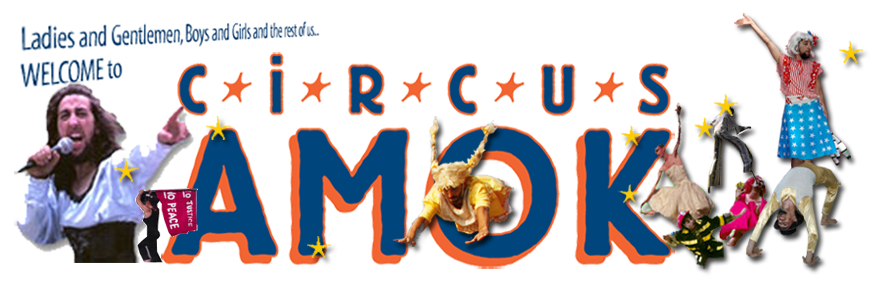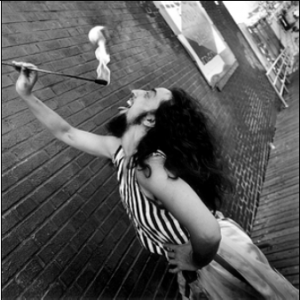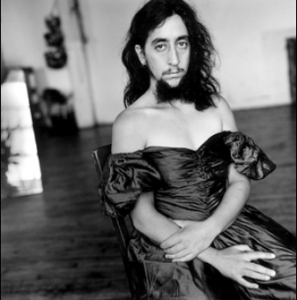STEP RIGHT UP! SEE THE BEARDED PERSON!
New York Times — Friday, June 9, 1995
By DINITIA SMITH
Three stiltwalkers are in a dusty yard on West 134th street in Harlem, surrounded by abandoned buildings. The stiltwalkers wear tops with stars and multi‑colored ribbons, striped pants, strange helmets with long plumes glittering in the sun. They are ambiguous figures. Male or female? One has a beard. But…you can’t be sure. This is the opening act of Circus Amok, an alternative circus performing in parks throughout New York City until June 18.
Now the band begins to play ‑ a samba on drums, trumpets, hubcaps, car springs. The stiltwalkers dance, chasing one another around the ring until the pace becomes frenetic. Suddenly, the stiltwalker with the beard falls backward and two roustabouts tear off the clothes, rip off the stilts. Underneath, the figure wears a dress of fuchsia satin. Slowly, the figure turns toward the audience. The hair is shoulder length and wavy, the beard about three inches long. Yet…the shoulders are soft, feminine.
“Is that a man or a woman?” a woman in the audience whispers.
“She’s a woman with the beard glued on,” a boy sitting next to the woman says.
“Welcome, ladies and gentlemen, boys and girls, welcome to Circus Amok,” the figure cries, in a woman’s voice.
Meet Jennifer Miller, 34, a real‑life woman with a beard and it isn’t glued on. Ms. Miller is a circus artist, performance artist, juggler and clown, and the founder and director of Circus Amok. The theme of today’s circus is the city’s budget cuts, and there are traditional circus acts laced with political, commentary. As the show continues, one performer delivers a short history of New York: “A green island surrounded by clear water, birds, fish, starry clear nights, peaceful fields… The Dutch came and stole it from the Indians.” A lion, with a mane of many‑colored ribbons, chases a clownish figure in a lace dress. There is a melancholy “Adagio With Newt,” a lament on budget cuts, as two women perform a slow‑motion dance fusing ballet and gymnastics.
After a few moments, the mood lightens as Ms. Miller performs as one of the Juggling Fratelli Brothers, juggling clubs with other members of the troupe, knocking a cigar from the mouth of one of the performers. This time, Ms. Miller wears padding in her shorts in imitation of male anatomy. And suddenly her arms seem strong, muscular. In another sequence a member of the audience ties Ms. Miller into a straitjacket. “This act has been done for centuries,” Ms. Miller says, as she tries to escape. “It means something to people: it means freedom,” she cries, breaking free in a few minutes.
As she performs, her beard flows freely. Onstage ‑ and in real life ‑ Ms. Miller flaunts what most women pluck, shave and hide in shame.
In another of Ms. Miller’s acts, her sideshow act, performed last month at the Queer Theater Festival at the Joseph Papp Public Theater, and occasionally at Coney Island, she confronts her audience head‑on as a “bearded lady,” in an amalgam of old‑time vaudeville and feminist theater. “I am a woman with a beard! ” she says, tugging at it to prove it is real. Her voice is playful, insinuating, with the exaggerated delivery of sideshow entertainers. “A woman with a beard, not ‘the bearded-lady!”‘ she says. “The world is full of women with beards,” she says. “Or at least they have the potential to have a beard … instead of spending the time, and the money, on the waxing, and the shaving, and the electrolysis and the plucking. We all know someone who plucks. Pluck, pluck, pluck, as if these women were chickens!” she cries.
“Hair is a symbol of power,” Ms. Miller says. “You’ve got Hair Club for Men: they all want it! It goes all the way back to Samson and his big mane of power. That’s why men don’t want women to have too much of it in too many places. So, here I am, a gal with a beard, prancing around the streets of New York.”
“You think I’m gettin’ hassled?” she asks. “I get more than my fair share. I have to talk to people. I ignore. I cajole. I argue. I educate. I run or I ‑” Suddenly, she grins, and holds up three gleaming machetes. “Forget the talking-“ starting to juggle the machetes, “-forget the cajoling! All I want is a nice, cold machete!”
A Long History
There is a long tradition of bearded ladies in American sideshows and dime museums. At the turn of the century, bearded ladies like Annie Jones, Lady Olga, Madame Devere and Princess Gracie were among the most popular exhibits. Bearded ladies ‑ along with Asians, African‑Americans, fat people, paraplegics, two‑headed fetuses and “other ways of looking that weren’t traditional, white and Protestant,” says Ms. Miller (a student of circus and sideshow history), “were another way to allow people to feel superior, less existentially lost.” Traditionally, bearded ladies were presented as the epitome of femininity. They wore elegant dresses, their hair was done in fashionable style. Gawkers at sideshows could congratulate themselves that at least they weren’t freaks, too. Jennifer Miller is both a part of this tradition and apart from it. Unlike bearded ladies before her, she doesn’t wear feminine clothes. From the moment she appears onstage, Ms. Miller confounds expectations: she parades her beard, forces her audience to look at it, and to ask questions.
At Home in Brooklyn
On a rainy day, Ms. Miller sits in her loft in the Williamsburg section of Brooklyn, talking about her life. She is wearing an androgynous costume today, a black sports bra underneath a loose white tank top, and black jeans. The loft is at once arresting and feminine: hanging from the walls are life‑size papier‑mâché horses embroidered with glass (made by Ms. Miller’s steady girlfriend, Alessandra Nichols, an artist) and exotic masks and props from Circus Amok. There is a gauzy curtain near the bed, glass beads strung on nails, jade plants; two big, fat cats, George and Gracie, are napping. Ms. Miller shares the space with Ms. Nichols and Scotty Heron, who works by day, in desk‑top publishing and is also a performer in Circus Amok. Mr. Heron sometimes wears a dress in the circus, or a bra and panties with sequins.
As Ms. Miller speaks, the mist rises from the river. Through the huge windows of the loft, abandoned docks and huge container ships are visible. Her voice is soft, almost dreamy, and sometimes a visitor has to lean forward to catch her words. “My dad was a professor of physics at Trinity College in Hartford,” she says. “My mom was a professor of education at Central Connecticut State College.” The tradition of teaching runs in the family; Ms. Miller sees herself as a teacher. Both her parents were Jewish, but she was reared a practicing Quaker. Historically, Quakers have often taken stubborn, independent positions. In the Quaker tradition, personal appearance doesn’t matter. It is each person’s “inner light” that counts.
She had a “normal, happy childhood,” she says. She was especially close to her mother, who died when Ms. Miller was 20. “I felt very warmly toward my father,” she says. “And I’ve since grown to be very close to him, too.” Her parents encouraged her artistic interests. In high school, before she had a beard, Ms. Miller performed in school plays, took courses in juggling and clowning. She also had her first sexual relationship with a woman. “I moved out of the house when I was 17 into the arms of late 70’s feminism,” she says. She never went to college: life itself was “too enticing,” she says. By her mid‑20’s, Ms. Miller had grown a full beard. She isn’t sure what made it grow. Once, she says a doctor told me I had high
progesterone.” She adds: “I don’t think of it as a problem, so I’m not looking for a cause.” So why doesn’t she shave? “The answer’s constantly changing,” she says. “It’s complex, not a sound‑bite. Comfort plays a role. And there would be a dark shadow. People would suspect. Electrolysis is unhealthy, painful and expensive. If it were a one‑time thing, I might have done it. But if I didn’t keep my beard, it would be a statement of hopelessness. Keeping secrets requires energy that’s debilitating, especially when it’s out of shame or fear.”
Once, when Ms. Miller was 20, her grandmother “dragged” her to electrolysis: “You couldn’t say no to her on any issue! Ever. I submitted, crying.” And for three short periods in her life, Ms. Miller did shave. It was always to get a job. Two summers ago, she had to shave for a job as a juggler and variety performer in a traveling circus. “It was hard, really hard, shaving,” Ms. Miller says. “I cried and cried.” But she needed the money.
“It’s a lifelong performance,” Ms. Miller says of the beard. “My daily life is a mundane thing. The beard rarely exists except when I talk about it.” Ms. Miller turned. “I’m seeing this as a performance project,” she says, “talking to you.” A friend of Ms. Miller’s, Susan Sizer, who is a graduate student in anthropology, says over the phone: “People are incredibly drawn to her. They’re faced with something they don’t know. ‘What is the gender of this person?’ But she’s learned to make people comfortable by herself being vulnerable. She presents an incredible openness.” Another friend, Dick Zigun, founder of the Coney Island Sideshow, says, “Jennifer is willing to carry the banner for freedom, for people to look the way they want to look.”
Baffling People
On another occasion, Ms. Miller takes a walk around her neighborhood with a visitor. On this day she is wearing a dress and sandals. “I wouldn’t go in this dress many places unless I were in a performance mood,” she says. She’s lived in Brooklyn for eight years. The Hasidic shopkeepers, the Hispanic people accept me because they know me,” she says. As she walks, a boy on his bike calls out, “Hey, Jennifer!” She stops in a grocery store run by a Hasidic family. The woman behind the counter is wearing a wig.
“Why so busy?” Ms. Miller asks. “Everyone’s back from the mountains,” the woman says. Ms. Miller’s Hasidic neighbors have never asked about her beard, she says later. But sometimes people in the street do accost her: “They say, ‘Hey, like can I ask you a question, like what is it that you are?’ I try to make them be explicit, make them see they already know the answer.”
Outside the neighborhood, Ms. Miller is cautious, and usually wears pants. She doesn’t go to big department stores. “I wouldn’t feel comfortable,” she says. “I wouldn’t go to a ladies’ room‑which had a long line. I have a lot of strategies for going to the ladies’ room. If it’s crowded, there’s too much time for standing and looking. I go with a friend and we talk, so people realize I’m a woman. It’s hard, the bathroom scene. I’ve been stopped. I’ve had to say, ‘Yes, I’m a woman.”
Ms. Sizer remembers once going to a drugstore with Ms. Miller: “We went to buy shampoo. Jennifer went up to the counter, and the woman couldn’t take her money, couldn’t ring up the cash register. I said, ‘This is impossible!’ She said: ‘Is it? I thought this was always the way things were.’ She thought it was normal to have people freeze up and not do their jobs.”
“People like to know what category they’re looking at,” Ms. Miller says. “Males speak up more. I’m not sure it’s more threatening to them. They’re just allowed to say what they think. I’ve been in on a lot of boy’s stuff, a prostitute calling out to you, inviting you to have sex for money.” As founder and director of Circus Amok, Ms. Miller has taken her transgressive art to communities potentially hostile to it. In 1989, she founded the circus, which is supported by grants from New York State and various foundations. The circus has traditional circus elements: animal acts, clowns, a charivari. But it’s also influenced by the Bread and Puppet Theater, with its giant masked puppets, actors on stilts and free outdoor performance, and by the Ridiculous Theatrical Company. “It’s ‘gender bent’ and ‘queer,”‘ Ms. Miller says.
Indeed, one show called “Endangered Species” features, says the circus announcer “the unbelievable sight of a surviving gay man!” Another, New York Ground Under,” is an “alternative” history of New York City, with Ms. Miller appearing as a bearded Statue of Liberty in a skit about the mistreatment of immigrants. Circus Amok performed that in a rough community in the South Bronx. “It went really well,” Ms. Miller says. “There are old clown bits, hundreds of years old,” Ms. Miller says of Circus Amok, “but done by gay people in flamboyant costumes. It allows the audience almost unknowingly to embrace gay culture. You have to have a playfulness in order to be serious.” But if she sees her beard as normal, why perform as a freak in circuses and sideshows? “It’s a strong, feminist piece of theater,” she says of her act. “Ten times a day, I address in the strongest, most forthright terms feminist issues of appearance and dress. I use the platform of the sideshow to defreakify.”
One day Ms. Miller hopes Circus Amok will be a full‑time enterprise, with a circus school where she could teach. She has taught before, in colleges, theater companies, day care centers and after‑school programs. “Kids get over the beard,” she says; “They don’t mind. They ask and they want to know. You’re straight with them. I’m sure they did some protecting of me when other kids would tease me. They’d stand up for me.”
I live in a very liminal place,” Ms. Miller says. “‘Liminal’ means: an ‘in‑between place,”‘ she explains. “It means ‘in a doorway, dawn
or a dusk.’ It’s a lovely place. In the theater, it’s when the lights go out. And before the performance begins.


